Welcome to BungeeCity.com, where we’re about to embark on a vibrant adventure filled with astonishing creatures that are sure to make you go bananas! Get ready to dive into a world of yellow wonders as we unveil the 12 most amazing yellow animals, complete with jaw-dropping pictures that will leave you in awe. From the sunshine of the sea, the Yellow Tang, to the venomous beauty of the Yellow Eyelash Viper, these yellow-hued creatures are as fascinating as they are eye-catching. So, grab your shades and let’s get started on this wild journey through the kingdom of yellow!
1. Yellow Tang: The Sunshine of the Sea
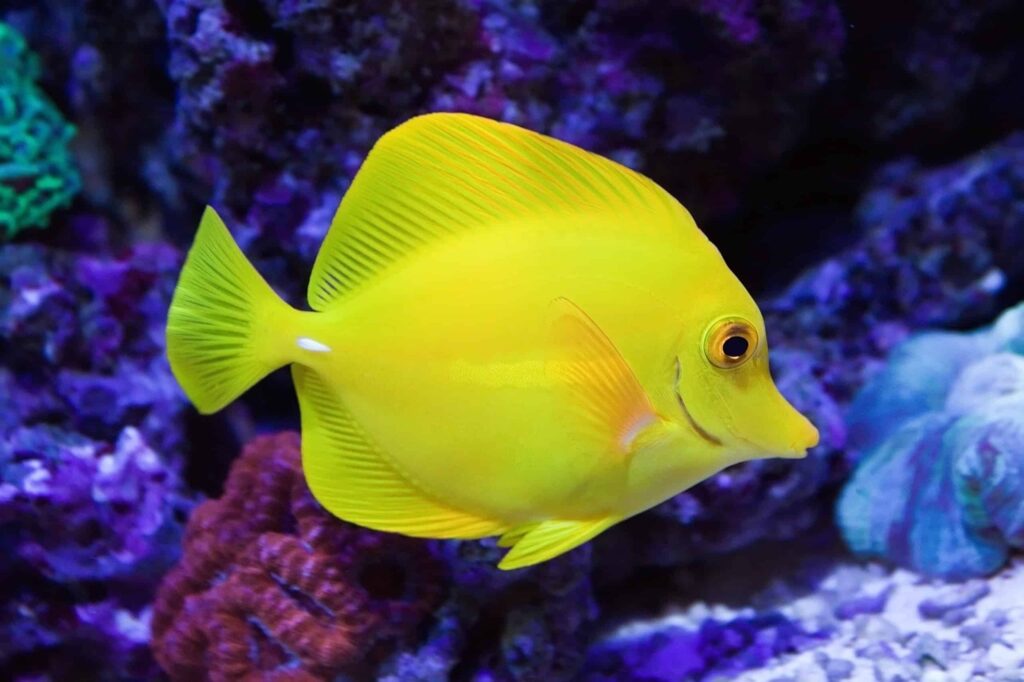
yellow tang
Imagine diving into the turquoise waters of the tropical Pacific Ocean, when suddenly, a splash of vibrant yellow catches your eye. That’s the Yellow Tang, a radiant creature that seems to have captured a piece of the sun and brought it to the sea. These tropical fish, with their stunning bright yellow color, are like rays of sunshine lighting up the depths of the ocean.
Belonging to the surgeonfish family, these fish make their homes in shallow coral reefs. They’re like underwater gardeners, busily nibbling away on algae, their main source of food. A fully grown Yellow Tang can reach up to 20 cm or about 8 inches in length—comparable to the size of an average dinner plate!
Also check out: How Big Are Wolves? A Fascinating Size Comparison with Dogs, Humans, and Other Wild Animals
What’s more, the allure of their vibrant hue extends beyond the ocean. Yellow Tangs have gained immense popularity in saltwater aquariums, their striking color adding a dash of sunshine to the aquatic setup. Due to this high demand, Hawaii, once a hotspot for wild Yellow Tang harvesting, had to impose a ban to protect the species from overfishing.
Thankfully, this led to innovative measures such as captive breeding, ensuring that the sunshine of the sea continues to thrive in our oceans and aquariums alike. Let’s dive into some quick facts about this radiant fish:
| Scientific Name | Type of Animal | Location | Size | Diet | Conservation Status |
|---|---|---|---|---|---|
| Zebrasoma flavescens | Fish | Tropical Pacific Ocean | Up to 20 cm or 8 inches | Algae | Protected in Hawaii |
So, next time you spot a Yellow Tang, either in the wild or in a home aquarium, take a moment to appreciate this little ray of underwater sunshine, the bright and beautiful Yellow Tang.
2. Yellow Eyelash Viper: A Venomous Beauty
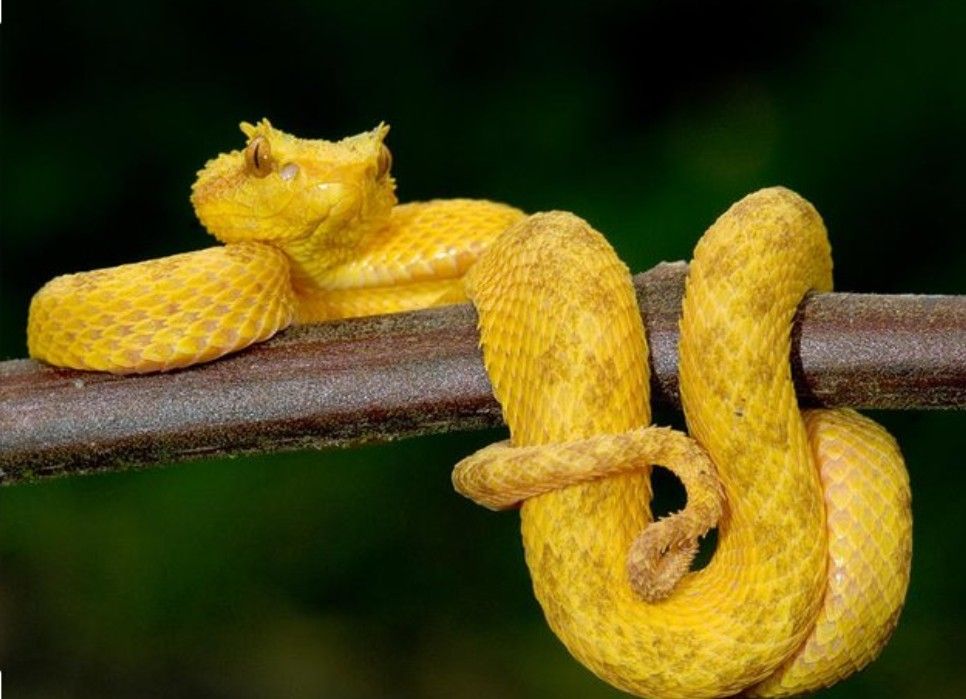
yellow eylash viper
Among the myriad of hues in the animal kingdom, the vibrant yellow of the Yellow Eyelash Viper is an undeniable head-turner. Just as the Yellow Tang is a beacon in the cerulean depths of the Pacific, this venomous pit viper brings a splash of color to the lush green canopies of the tropical rainforests.
This nocturnal creature, much like a well-crafted suspense novel, unfolds its story under the cover of darkness. As night descends, it embarks on a silent hunt, blending seamlessly into the foliage. Its vibrant color, rather than betraying its presence, aids in its strategy of ambush.
From the tiniest rodents to unsuspecting birds, from swift lizards to agile frogs, none can escape the viper’s deadly grip. It’s a master of stillness, patiently awaiting its prey, striking with a speed that leaves its victims with little chance of escape.
Their name, Yellow Eyelash Viper, is no mere coincidence. It’s a nod to the distinctive scales that hover above their eyes, mimicking the delicate fringe of eyelashes. This unique feature lends them an almost deceptive gentleness, belying their lethal nature.
Moving further into the mysteries of this species, we discover yet another fascinating aspect – its mode of reproduction. The Yellow Eyelash Viper is ovoviviparous, a term that paints a vivid picture of the survival tactics of these creatures. Unlike many reptiles that lay eggs, this viper’s eggs hatch within the mother. This internal birth process offers the hatchlings an immediate shelter, protecting them from predators right from their birth.
These fascinating creatures weave their tales of survival and predation across a wide geographical stretch, from the vibrant landscapes of southern Mexico, through the diverse terrains of Colombia, Venezuela, Ecuador, and Peru, to the rich biodiversity of Costa Rica and Panama. They are a testament to the incredible adaptability of life, thriving in the humid tropical rainforests of Central and South America.
Just as the Yellow Tang beautifies the seascape, the Yellow Eyelash Viper adds a dash of deadly beauty to the rainforest canopy. Their vibrant color, stealthy hunting techniques, and unique reproductive habits make them a captivating part of our planet’s diverse fauna.
3. Golden Rocket Frog: The Yellow Jewel of Guyana
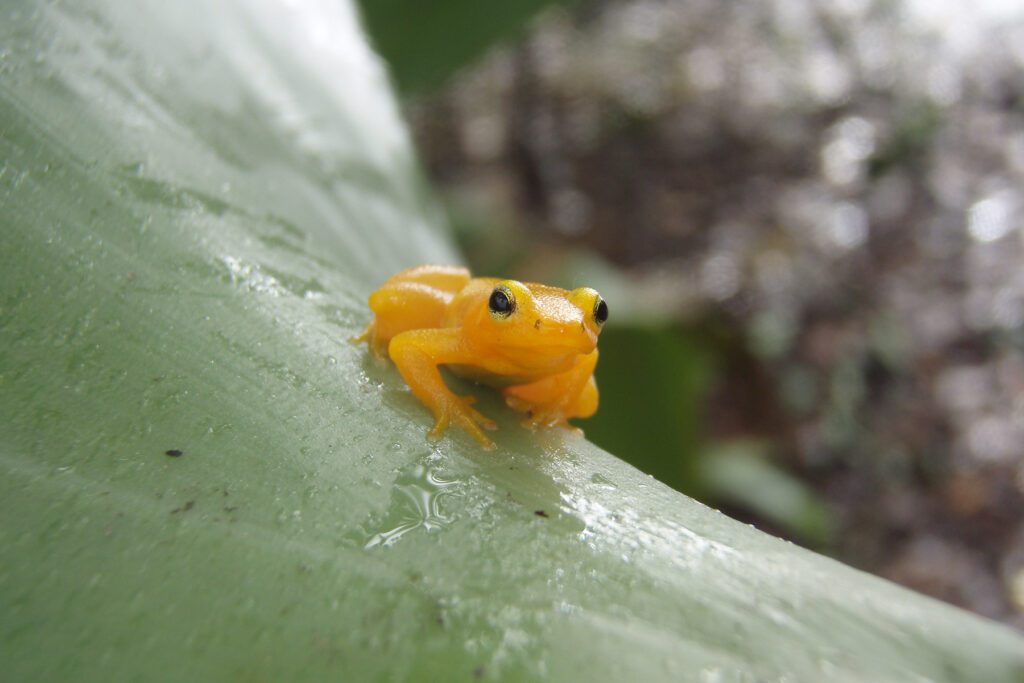
golden rocket frog
Nestled in the heart of South America, within the lush green expanses of Guyana’s Kaieteur National Park, resides a remarkable amphibian—the Golden Rocket Frog. This tiny creature, with its radiant golden hue, stands as a stark contrast to the dense greenery surrounding it, mirroring the vibrant allure of the Yellow Tang and Yellow Eyelash Viper we explored earlier.
Despite their striking resemblance and size similarity to the well-known poison-dart frogs, these miniature jewels are, intriguingly enough, not poisonous. A surprise, isn’t it? They may share the same vibrant color palette, but unlike their dangerous counterparts, the skin of the Golden Rocket Frog doesn’t harbor any toxins.
One of the Golden Rocket Frog’s most fascinating traits lies in its peculiar reproductive process. The life story of this amphibian begins in the giant tank bromeliad leaves, which house miniature pools formed by rainwater. It’s in these cozy, natural nurseries, known as phytotelmata, where these frogs lay their eggs, providing an immediate sanctuary for their offspring.
But it doesn’t stop there! The Golden Rocket Frog is an ovoviviparous species. This means the eggs hatch internally, and the mothers give birth to live young. This unique adaptation ensures immediate protection for the fragile froglets, shielding them from potential predators.
Just imagine, these tiny creatures, no larger than your thumbnail, carry within them the future of their species, safeguarded in their unique, internal nurseries. It’s an intriguing illustration of the myriad ways nature ensures survival.
So, next time you find yourself wandering through the damp, dense rainforests of Guyana, keep an eye out for these tiny golden jewels. They are a testament to the marvels of adaptation, the beauty of diversity, and the resilience of life in even the most challenging of habitats.
4. Yellow Duckling: A Splash of Sunshine in the Animal Kingdom
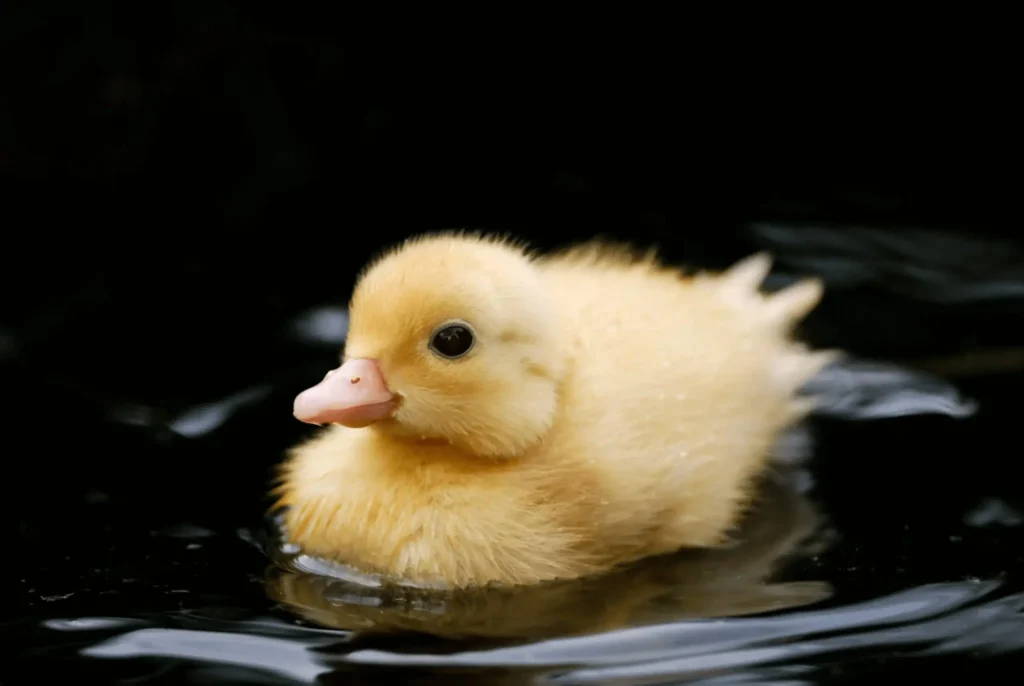
yellow duckling
Oh, the delightful sight of a Yellow Duckling! This vibrant, cuddly creature belongs to the American Pekin Duck species, a domesticated bird that has captured hearts across the globe. Don’t be fooled by their common appearance in picture books and cartoons; these cute little birds have a fascinating history and a life cycle that is a marvel of nature.
Read more: What Animals Prey on Beavers? Discover the Top 10 Natural Predators
The roots of the Pekin Duck can be traced back to China, where they were first domesticated thousands of years ago. In the 19th Century, they journeyed from their homeland to the shores of America, heralding the start of an impressive expansion. Today, tens of millions of these ducks are raised primarily for meat production in the U.S., a testament to their adaptability and the high regard in which they are held.
Though adult ducks sport a pristine white plumage with yellow beaks, legs, and feet, it’s the ducklings, with their captivating yellow fluff and pinkish beaks, that truly steal the show.
The transformation from a Yellow Duckling to a full-grown duck is a sight to behold. When they hatch, they are entirely yellow – a splash of sunshine in the animal kingdom. This yellow fluff is not just aesthetically pleasing; it also serves a crucial role in providing warmth and protection to the newborns.
As the ducklings grow, they embark on a color-changing adventure. At around 6 to 8 weeks of age, their yellow fluff begins to recede, replaced by the white feathers characteristic of their adult counterparts. This metamorphosis is not just a change in appearance; it signifies their transition into adulthood, ready to face the world in their new, white attire.
Next time you spot a Yellow Duckling, remember, you’re not just looking at an adorable bird, but a remarkable creature that embodies the wonder of nature’s transformations.
5. Yellow Warbler: The Bright Songbird
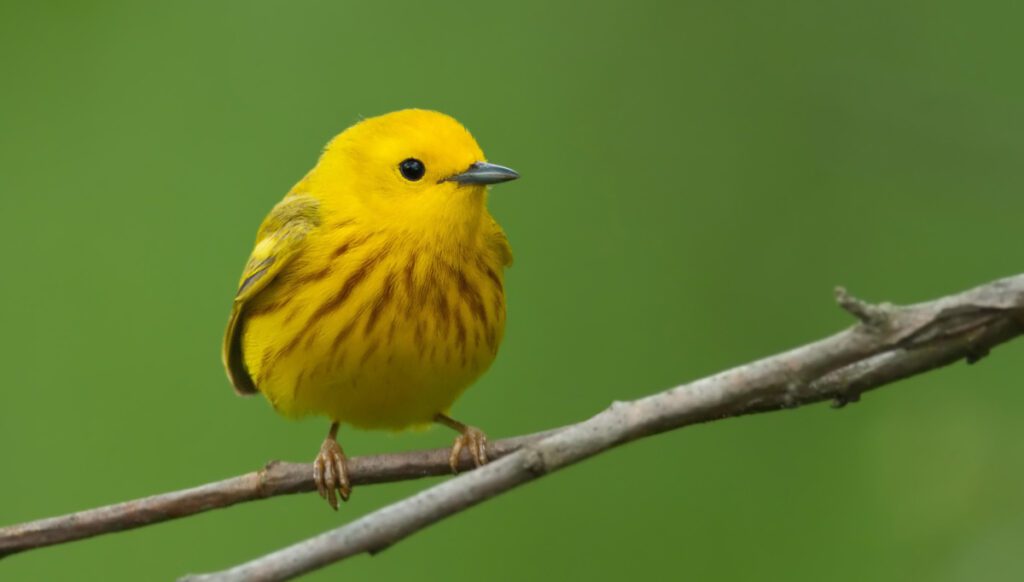
yellow warbler
Meet the Yellow Warbler, a common passerine bird, that is like a spark of sunshine in the vast avian world. With its vibrant yellow plumage, it brings a delightful color palette to the diverse habitats of North America. This tiny, yet significant creature plays a unique role in the ecosystem, symbolizing the diverse tapestry of life on our planet.
Its name does not just denote its color, but also its spirit. Just as the color yellow represents happiness and optimism, the Yellow Warbler brings joy to birdwatchers with its lively presence and melodious song.
“The Yellow Warbler is more than a bird; it’s a living artwork that portrays nature’s brilliant palette.”
When it comes to food, this bird has a voracious appetite for caterpillars, small insects and their larvae, spiders, and berries. Its diet reflects its adaptability and resilience, as it navigates through various ecosystems, from the chilly tundra in the north to the tropical mangroves in the West Indies.
| Scientific Name | Type of Animal | Where Found |
|---|---|---|
| Setophaga petechia | Bird | Americas |
Did you know that there are no less than 35 subspecies of the Yellow Warbler? These subspecies can be grouped into three categories, one of which, the Yellow American Warblers, migrates south to Central and northern South America during the winter. This migration pattern is a testament to the bird’s incredible adaptability and resilience.
The Yellow Warbler’s striking yellow plumage is, of course, its most defining characteristic, but it’s more than just a pretty sight. This vibrant coloration helps them blend into the foliage and evade predators like birds of prey.
Join us as we continue this vibrant journey into the world of yellow creatures, each with their own unique stories and adaptations.
6. Albino Burmese Python: The Yellow Giant
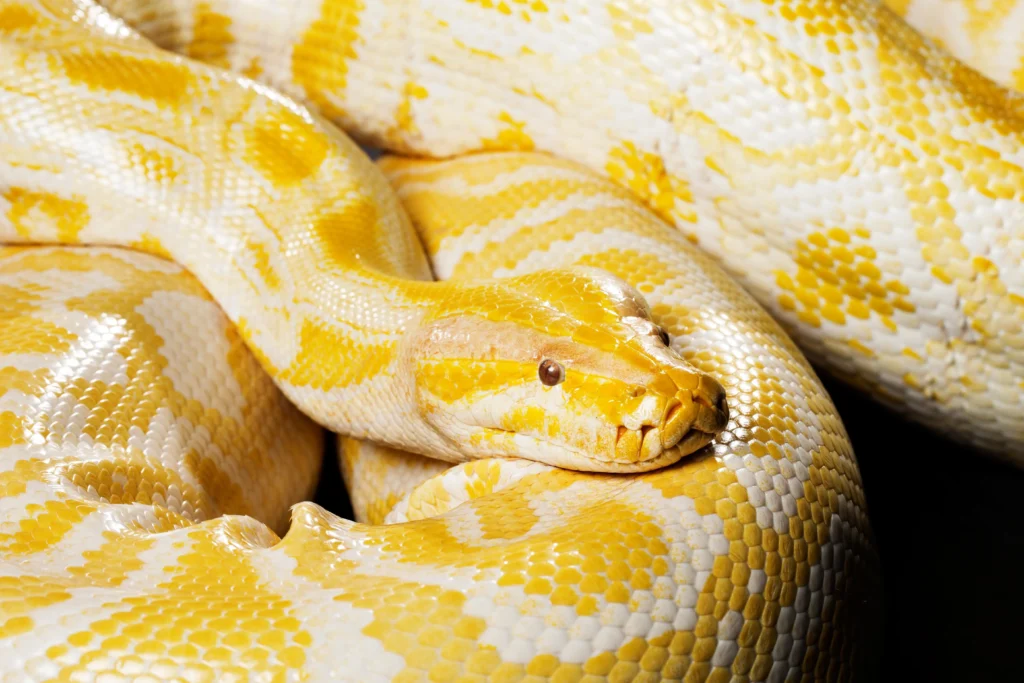
albino burmese python
Imagine an imposing creature, gleaming with a brilliant blend of white and yellow, slithering its way through the lush landscapes of South and Southeast Asia. This is no ordinary inhabitant of the wild; it is the magnificent Albino Burmese Python, a genetic marvel among snakes. Its vibrant hues, a stark contrast to the typical dark brown of its species, make it a truly fascinating sight to behold.
This yellow giant is a non-venomous yet formidable constrictor snake. Its strength lies not in venom, but in its incredible power to constrict and squeeze the life out of its prey, a testament to the diverse ways in which nature equips its creatures for survival. Its size further adds to its awe-inspiring stature. Growing up to 5 meters (16 feet) and weighing as much as 75 kg (165 lbs), the Albino Burmese Python is a testament to the grandeur of the reptilian world.
What sets the Albino Burmese Python apart is its unique coloration. This genetic variation results from albinism, a condition that completely strips the snake of melanin, the pigment responsible for color in animals. This lack of melanin not only affects the snake’s skin but also its eyes, giving it an otherworldly appearance that is as breathtaking as it is rare.
Despite its intimidating size and strength, the Albino Burmese Python is a favorite in the exotic pet trade. Its striking appearance and docile nature, combined with its rarity, make it a highly sought-after pet for those with a liking for the extraordinary.
However, as we marvel at these yellow giants, it is essential to remember that they are not just beautiful creatures to be admired, but also an important part of our ecosystem. Each Python bivittatus, as they are scientifically known, plays a vital role in maintaining the balance of nature, further highlighting the wonder of these yellow animals.
7. Banana Slugs: The Vibrant Yellow Decomposers
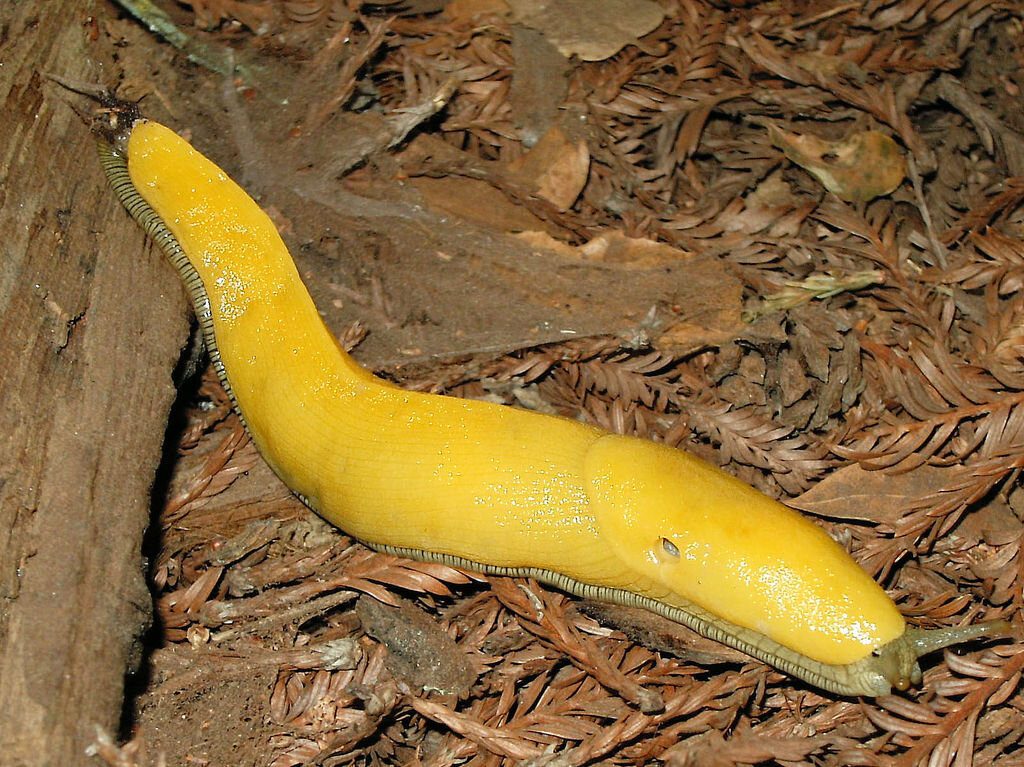
banana slug
Now, let us venture from the melodious melodies of the Yellow Warbler and the captivating charm of the Albino Burmese Python to the enchanting forest floors of North America, where we encounter a creature as astonishing as it is vital: the Banana Slug.
These intriguing beings belong to the genus Ariolimax, and they are not just one, but five distinct species of mollusks. They bear the playful nickname ‘Banana Slugs’ due to their strikingly bright yellow color, reminiscent of the ripe tropical fruit. However, the yellow hue varies in intensity across species and even among individuals of the same species. Some Banana Slugs may sport black spots, while others might exhibit greenish or brownish tints.
But what truly makes them spectacular is not their vibrant color but their crucial ecological role. As decomposers, Banana Slugs are the unsung heroes of the forest ecosystem. They laboriously consume dead leaves, fallen twigs, and other deceased plant parts, converting them into a nutrient-rich soil known as humus. This humus, teeming with vital nutrients, forms the lifeblood of the forest, nourishing the plant life and ensuring the forest’s continued growth and survival.
Also check out: Do Lions and Tigers Share the Same Territory in the Wild?
These fascinating yellow decomposers can be found along the Pacific coast of North America, from the icy climes of Alaska all the way down to the sunny Californian coast. They flourish in the dense conifer forests, where they blend effortlessly into the leaf-strewn forest floor.
As we leave the forest floor and the Banana Slugs behind, we prepare to dive into a completely different habitat with our next yellow marvel, the Spiny Seahorse.
8. Spiny Seahorse: The Thorny Yellow Seahorse
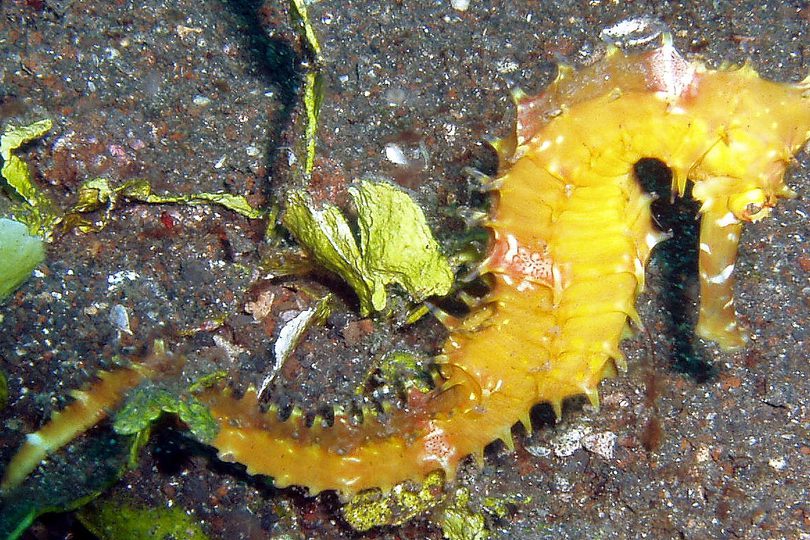
spiny seahorse
Imagine a miniature submarine floating through underwater forests of kelp and coral, its bright yellow to greyish armor glistening under the filtered sunlight. This is not a scene from a sci-fi movie, but a snapshot of the life of the unique Spiny Seahorse, also known as the Thorny Seahorse.
Native to the mysterious depths of the Indian and Pacific Oceans, the Spiny Seahorse boasts an array of colors as vast as the marine landscapes it calls home. Its hues range from a vibrant yellow to a subtle brown, and even greenish, reddish, or greyish. This adaptive coloring serves as the perfect camouflage amidst the diverse oceanic scenery.
What sets this creature apart is not just its striking appearance, but also its peculiar anatomy. Covered in spines, its body is a testament to nature’s brilliant design for survival. These spines, which lend the seahorse its name, are not only for protection but also a unique form of identity among these creatures. Each Spiny Seahorse has a different pattern of spines, much like human fingerprints.
Another astonishing fact about this species is its unusual reproductive process. In a remarkable reversal of roles, it is the female who transfers her eggs to the male. The male then carries the eggs in a special ventral pouch where they are fertilized and nurtured until they hatch.
Read more: Coyote vs. Fox vs. Wolf: Which Canid Reigns Supreme in the Animal Kingdom?
Despite their delicate and fragile appearance, Spiny Seahorses are surprisingly hardy. They can be found dwelling in waters as deep as 15 to 95 meters (50 to 310 feet), thriving amidst seagrass beds, corals, or sponges. Their existence is a testament to the robustness of life even in the most challenging conditions.
In the grand orchestra of nature, the Spiny Seahorse plays its part beautifully. Offering a glimpse into the unique diversity that our oceans hold, it serves as a reminder of the importance of preserving these underwater ecosystems.
9. Atlantic Ghost Crab: The Yellow Crustacean that Haunts the Beaches
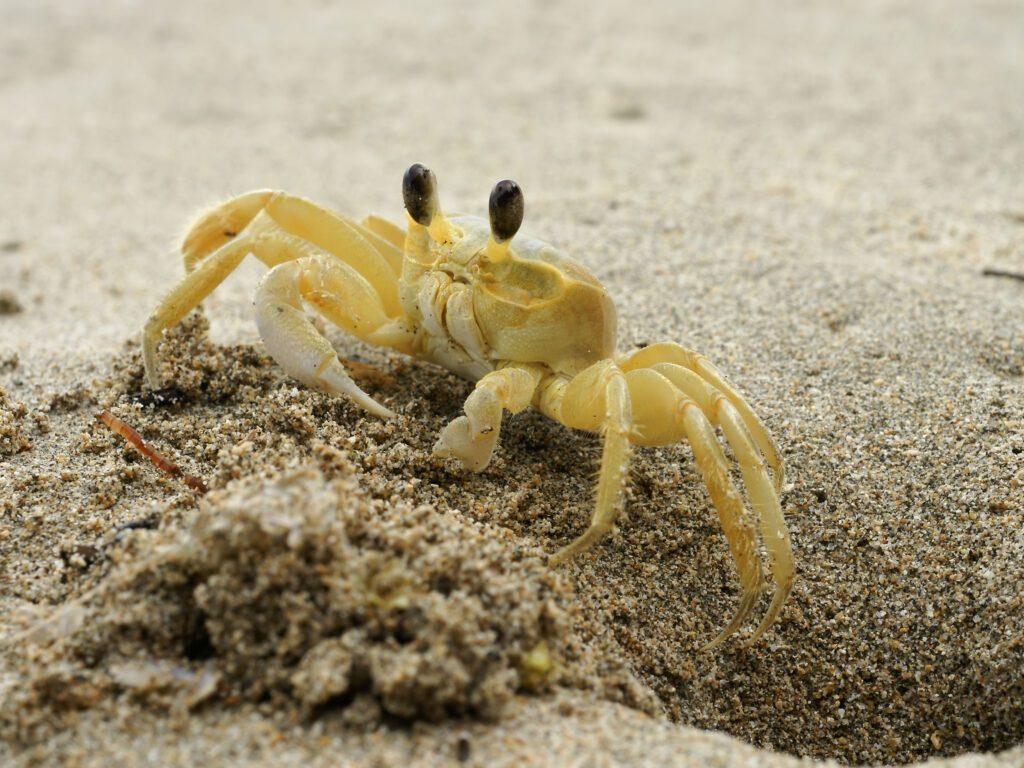
atlantic ghost crab
Just as the sun sets along the Atlantic coast, a unique creature emerges from its sandy burrow, its pastel yellow shell gleaming under the moonlight. A prominent resident from Massachusetts to Florida, Bermuda, and even some regions of the Brazilian Atlantic Coast, the Atlantic Ghost Crab (scientific name: Ocypode quadrata) is a sight to behold. Unlike the yellow Banana Slugs found in forests or the deep-water dwelling Spiny Seahorses, this crustacean species has made the sandy beaches its home.
This nocturnal creature thrives under the cover of darkness, becoming one with the sandy landscape thanks to its pastel yellow hue. Much like a ghost, it blends invisibly with its surroundings, using this natural camouflage as a means to sneak up on prey and evade predators.
The diet of the Atlantic Ghost Crab is as diverse as the colors of the Spiny Seahorse. This yellow crustacean is an omnivore, feasting on a rich variety of meals, including clams, other crustaceans, plants, and even sea turtle eggs. It has also been known to scavenge for various kinds of detritus and insects, contributing to the beach’s ecosystem much like the Banana Slugs do in forests.
Did you know? The Atlantic Ghost Crab changes its color to match its sandy environment, making it a master of disguise!
Yet, amidst this vibrant life, the Atlantic Ghost Crab faces challenges. Light pollution, a side-effect of human progress, often disturbs these nocturnal beings. The artificial lights confound their natural rhythms, causing disorientation. Additionally, beach vehicles pose a lethal threat, often crushing these small creatures under their wheels.
The Atlantic Ghost Crab’s story is a reminder of the delicate balance of nature, where even the smallest disturbance can have far-reaching impacts. As we marvel at these yellow creatures, let us also remember our responsibility in preserving their habitats for future generations to admire.
As we proceed to further explore the world of yellow animals, let’s continue to appreciate the rich diversity and the unique survival strategies these creatures employ. Up next, we’ll meet yet another yellow marvel, the Clouded Sulphur Butterfly, a delightful creature that brings a splash of color to our gardens. Stay with us as we delve deeper into this fascinating world.
10. Clouded Sulphur Butterfly: The Yellow Flutter
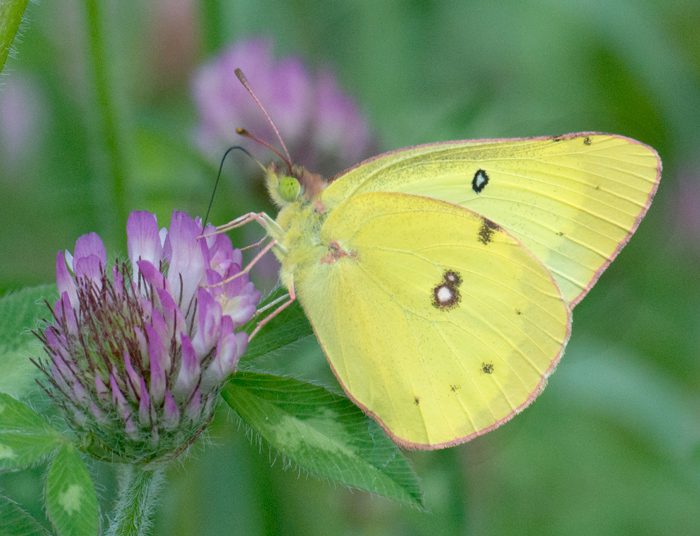
Clouded Sulphur Butterfly
Let us turn our attention from the sandy beaches inhabited by the Atlantic Ghost Crab to the lush meadows of North America, the preferred dwelling of the enchanting Clouded Sulphur Butterfly or Colias philodice. Known for its delicate beauty, this butterfly, affectionately known as the common sulphur, adds a splash of yellow to the green tapestry of meadows, fields, and lawns.
Imagine a warm, sunny day, the air buzzing with the sound of summer. Amid the vibrant greenery, a flash of yellow catches your eye. It’s the Clouded Sulphur Butterfly, fluttering agilely from flower to flower, sipping nectar and painting an idyllic picture of nature’s harmony.
Check out: What Eats Kangaroos? Unveiling the Top 6 Predators and Surprising Herbivorous Non-Predators
While the Clouded Sulphur Butterfly is a welcome sight in North America, its presence is not limited to this continent. In fact, this pretty yellow butterfly also exists in a white variation, known as the alba form. Despite their different shades, they are identical in all other respects.
It’s important to note that the Clouded Sulphur is not to be mistaken for its orange relative, the Orange Sulphur. How to differentiate them? Simple. The Clouded Sulphur is a pure embodiment of yellow, sporting no orange hues at all.
These butterflies are as resilient as they are beautiful. Much like the Spiny Seahorse from our earlier section, the Clouded Sulphur thrives in diverse environments. From meadows to fields, lawns, and even roadsides, these butterflies add a dollop of sunshine wherever they go.
As we journey from the depths of the sea to sandy beaches and now fluttering above meadows, our exploration of yellow animals continues to underscore the diversity and beauty of the animal kingdom. Let’s move on to our next yellow marvel, the Crab Spider.
11. Crab Spider: The Yellow Ambush
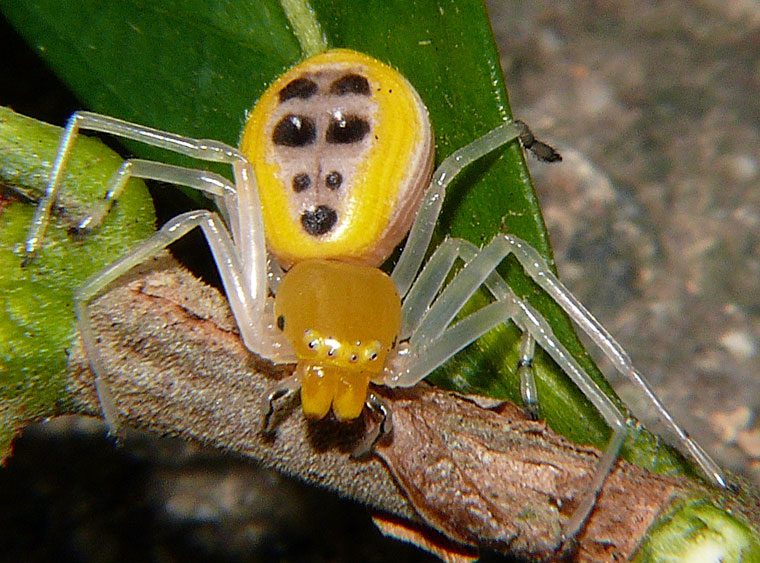
crab spider
Stepping into the fascinating world of arachnids, our next guest in this vibrant parade of yellow animals is none other than the intriguing Crab Spider. This unique creature, a part of the family Thomisidae, boasts an impressive diversity, with over 2100 species scattered across the globe.
Often affectionately dubbed ‘flower spiders’, Crab Spiders are a canvas of colors, and not just yellow. They wear a palette ranging from pink, green, white, to brown, and gray. Their colorful attire is more than just a fashion statement. It serves as a strategic camouflage, enabling them to blend seamlessly into their surroundings, particularly when nestled among blooming flowers.
But what sets these arachnids apart is their extraordinary hunting technique. Unlike their web-spinning cousins, Crab Spiders are ambush predators. Lying in wait, they patiently bide their time till an unsuspecting prey comes within their grasp. Then, with a swift, deadly precision, they strike, capturing their meal in an impressive display of predatory prowess.
One species that stands out in this diverse family is the Goldenrod Crab Spider, scientifically known as Misumena Vatia. Mainly found in the Northern Hemisphere, these spiders are a common sight in meadows and gardens. Their golden-yellow hue perfectly mimics the goldenrod flowers they often inhabit, making them the masters of disguise.
Interestingly, female Goldenrod Crab Spiders are significantly larger than their male counterparts, measuring 7-10 mm in body length compared to the males’ 3-4 mm. Not only do they overshadow the males in size, but the females also flaunt more vivid colors, while the males usually bear more dull brown or gray hues.
Whether you’re an arachnid enthusiast or simply an admirer of nature’s diverse color palette, the Crab Spider, with its vibrant hues and fascinating hunting techniques, serves as a captivating example of Mother Nature’s creativity in the animal kingdom.
12. Southern Masked Weaver: The Yellow Builder
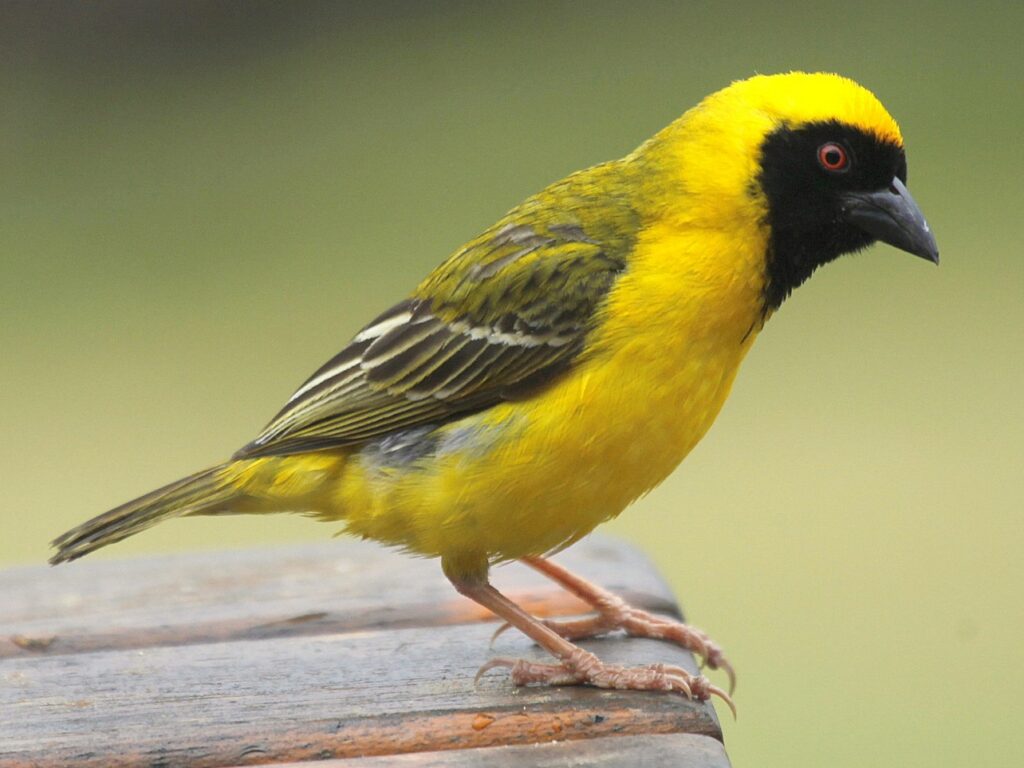
southern masked weaver
The next enchanting creature on our list is the Southern Masked Weaver, a vibrant avian marvel hailing from the diverse landscapes of Southern Africa. Its vivacious yellow plumage, elegantly accented with grey patterns on its wings and tail, sets it apart from its peers. But what truly captures the imagination is the distinctive black mask adorning its face, a feature that gives this bird its unique name.
The Southern Masked Weaver is a testament to the adaptability of nature. It thrives in a plethora of habitats, from the expansive grasslands and vast savannas to the lush wetlands. Remarkably, this bird has even adapted to cohabitate with humans, often spotted in urban parks and gardens, adding a splash of yellow to our concrete jungles.
However, it’s not just the striking color or adaptability of the Southern Masked Weaver that earns it a spot on our list of amazing yellow animals. This species is renowned for a remarkable skill – it’s a master architect. From September to January, these birds embark on an incredible construction project, weaving intricate hanging nests with the precision of seasoned builders.
Using materials like reed, grass, or palm leaves, the Southern Masked Weaver meticulously constructs each nest, hanging them strategically in trees. This extraordinary architectural feat is not merely for shelter but also serves as a testament to their courtship rituals.
This bird’s industrious nature and vibrant hue make it a captivating subject in our exploration of yellow animals. Their story is a reminder of the boundless wonders of the natural world, and the roles colors play in the grand tapestry of life.
Yellow animals can be found in various groups such as fish, insects, mollusks, reptiles, and birds.
The yellow tang is a bright yellow fish found in the tropical parts of the Pacific Ocean.
The yellow eyelash viper is found in the humid tropical rainforests of Central and South America.
Banana slugs are nicknamed banana slugs for their bright yellow color, which can vary in intensity from species to species and from individual to individual.

